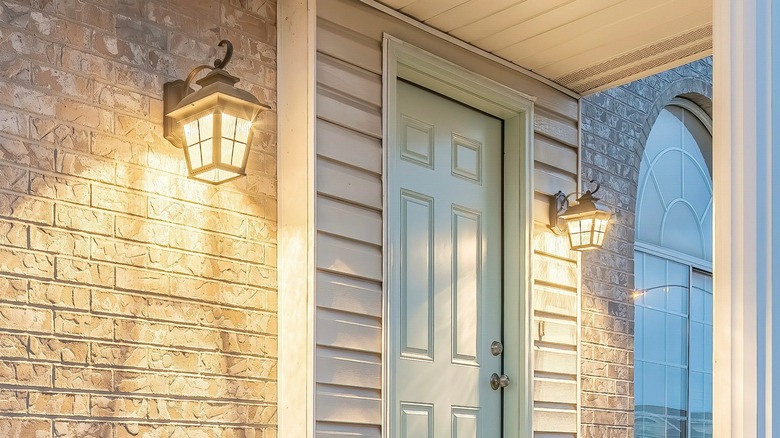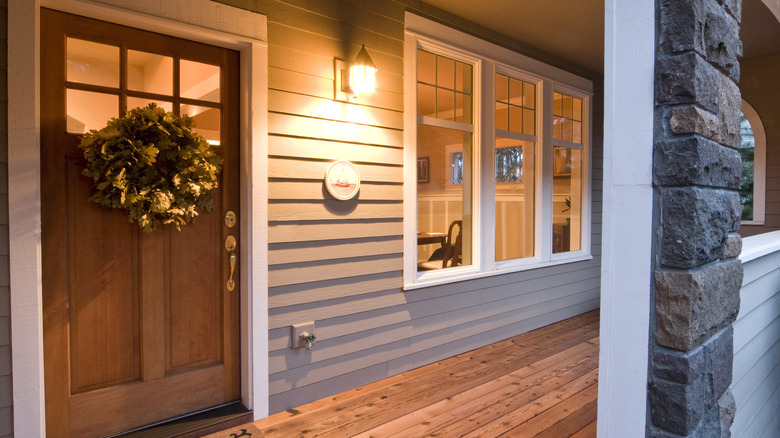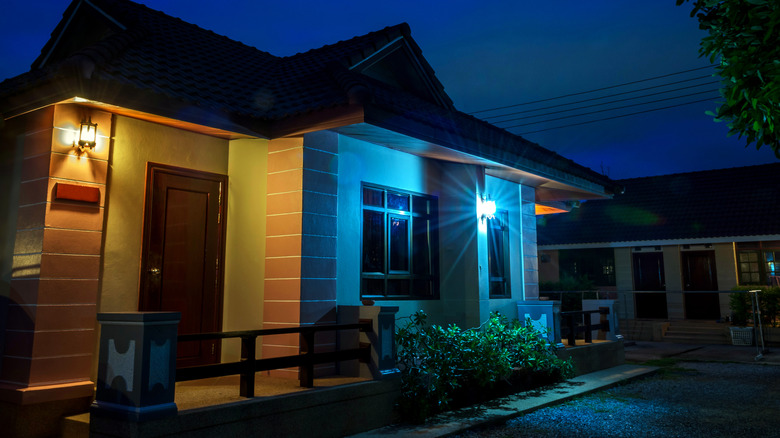What It Means If You See A Home With A White Porch Light
Porch lights are an extremely popular addition to a home for both personal safety reasons and aesthetic inspiration. Like yard signs and flags, different porch light colors can serve as outlets of self-expression or a means to vocalize the causes you're most passionate about. For instance, a red light may burn to celebrate Valentine's Day, while a green light may shine to honor veterans and support our military. While some spirited homeowners swap their standard porch lights for more festive colors during holiday seasons, others may opt to keep their lights white year-round for a simpler appearance.
Aside from serving as one of the most classic examples of outdoor lighting, white porch lights also carry a purpose of their own, albeit a less distinctive one. A white porch light traditionally serves as a nonverbal way to welcome guests to your humble abode, alerting them to whether you or other residents are home while bathing your house's otherwise dark exterior in a homey, comforting light.
Porch lights are practical for homeowners, too. The accessories have long served the purpose of keeping burglars at bay by illuminating potential hiding spots along the front of your house. They can also signal expected guests who may be unfamiliar with your neighborhood and increase visibility across your yard to guide them to and from your front door. Keep reading to learn more about the symbolism of white porch lights and how to determine whether warm- or cool-toned white porch lights are best for your household.
White porch lights create a welcoming atmosphere
White porch lights aren't as easy to interpret as other brighter colored lights. For many households, the lights bear no specific cultural meaning, nor do they carry any message of support for a social cause. Rather, they simply serve as the default outdoor lighting option for residents, accentuating their front doors and porches without diverging too much from the aesthetics established by their neighbors.
However, the reasons for having white porch lights and how often people use them have shifted over the past several decades. During the 1960s and 1970s, homeowners usually refrained from switching on their porch lights unless they were entertaining or expecting company. But as crime picked up over the years, homeowners started to rely on porch lights for security, leaving them on throughout the night (or at least until bedtime) to ward off thieves and expose any unwanted guests who may lurk in the shadows.
Despite slight changes in practical usage over the past couple of generations, the significance of white porch lights ultimately remains the same across most households in America. Homeowners commonly turn their porch lights on to communicate with neighbors, visitors, and loved ones, notifying them of their absence or presence or helping guests navigate to and from their front porch at night. Now, they also serve decorative purposes, and some homeowners get creative with outdoor light fixtures to craft a curb appeal that's worthy of attention from passersby and the most reputable home improvement publications.
Which white light bulb is best for outdoor use?
Though white porch lights remain a popular choice for those looking to illuminate their homes' exteriors, choosing the right light for your house may seem impossible. White light bulbs come in a variety of shades, sizes, and styles, each of which can drastically alter the look of your porch and home's exterior. For example, light-emitting diode lights, or LED lights, can offer a very different glow when compared to their classic, incandescent counterparts and, in turn, offer an array of different benefits. The type of bulbs you select depend on your household's needs, as well as the type of ambiance you want your outdoor lighting to establish.
Incandescent light bulbs tend to emit a warm radiance that appears almost yellow in the dark. Contrarily, LED lights usually emit a cooler, brighter glow while consuming less energy and lasting longer. These energy-saving lights are also less likely to draw the attention of pesky insects, like mosquitoes and June beetles, making them an effective way to keep bugs away from your porch lights. LED lights can sometimes even appear blue instead of white.
Some may view the bright, cool hue of LED lights as too harsh or intense for entertaining, opting to use them elsewhere for security. If you aim to create an amiable and welcoming atmosphere with your outdoor lighting, incandescent bulbs may offer the look you're after. However, if security is your foremost priority, LED bulbs may be your best option.


